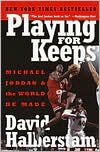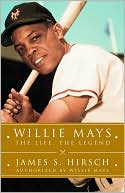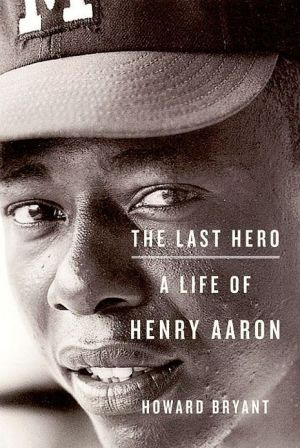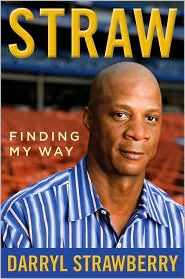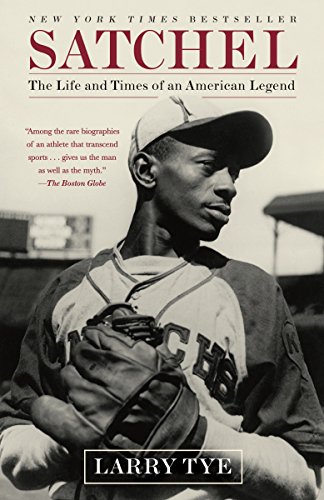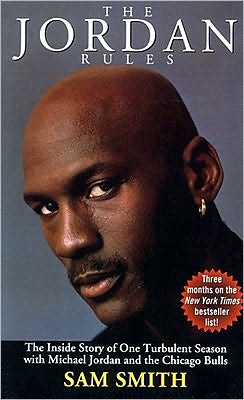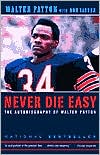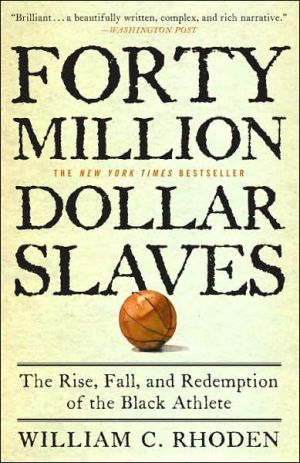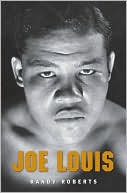Playing for Keeps: Michael Jordan and the World He Made
The author of the number-one bestseller The Summer of '49 and other seminal books about American sports, politics, and culture now turns his attention to a modern American legend — Michael Jordan — whose name alone evokes excellence. Halberstam explores Jordan's character and achievements, not only as a professional champion, but as a teenager and student athlete. Halberstam also chronicles the commercial forces that have changed the game during Jordan's career and the people behind those...
Search in google:
This is a sweeping, smart analysis of the full story of Michael Jordan from one of the countries most thoughtful historian-journalists. Halberstam covers Michael the teenager, Michael the rising star, Michael the champion, Michael the brand, and Michael the man in his effort to build a portrait not just of one player, but of the larger picture of American sports today and the larger social role of Jordan as the most recognizable man on the planet. It's a book about basketball, and, as with great moments in sport that transcend their playing field and tell us something about ourselves, it is a book about the nation.People Magazine - Alex Tresniowski...[A] thoughtful and fascinating study of Jordan's far-reaching impact on American culture, compiled byone of the most doggedly analytical authors around.
In the fourteen years that Michael Jordan played in the NBA, no one other than a handful of players benefited more from the league's rising affluence and the shift in power from owners to players than David Falk. A relatively junior sports agent in the beginning of the era, Falk was by 1998 not merely the most affluent agent ever to represent basketball players but one of the two or three most influential men in the sport of basketball, a man whose power was said to rival that of David Stern himself. If the legal, economic, and technological changes that took place in the eighties and nineties had been good for players, they were arguably even better for agents. Since he first surfaced as an agent, he had split twice with partners: Early on, even before he was part of Jordan's team, he and Donald Dell split from Frank Craighill and Lee Fentress, and eventually he split off from Dell in what was considered a rather bitter professional divorce. In 1998 he sold his company to a larger firm, one that specialized in producing live entertainment in arenas around the country. The price was an estimated $100 million, and as part of the deal, Falk stayed on to run his part of the company. A press release announcing the sale noted that Falk's old company, FAME (Falk Associates Management Enterprises), "represented an unprecedented 6 first-round draft picks in the NBA, negotiated over $400 million in contracts for its free-agent clients, and negotiated four of the five largest contracts in team sports history."\ No one doubted David Falk's ability and intelligence, but if there was one thing that bothered people who cared about the league and the game in the broadest sense, it was whether he had any sense of a larger good, a belief that the greater good and health of the game was still something of an issue. Some felt that there was a danger that the size of some players' contracts exploited the vulnerability of varying franchises and threatened the long-range stability of the league. Falk seemed to enjoy his power as much as his wealth, the ability not to return calls and to make other people, particularly owners, feel vulnerable to him. "Be wary of David, and be particularly careful when he starts telling you how much he respects you," an owner once noted. "That's when you're going to either lose your wallet or your franchise player--it's his way of telling you he's more powerful than you are."\ In the summer of 1998, as the league and the players' union prepared for a major battle over contract rules and the owners prepared for a lockout of the players, a number of Falk clients, including Patrick Ewing, Dikembe Mutombo, and Alonzo Mourning, had risen (hardly by chance) to positions of leadership in the union. That did not mean that it was simply Falk against the owners, for there were a number of other agents equally active on the players' side, but the issues, particularly the question of a soft or hard salary cap, seemed more about the contract freedoms enjoyed by the elite of the league than the earning power of most players. Certainly a number of people knowledgeable about the NBA saw the lockout as something of a struggle between Stern and Falk, and certainly when David Falk spoke to reporters that fall, he implied that Michael Jordan might be willing to come back for one more season--if David Stern did not block the way. As the lockout continued, it became increasingly clear that Falk was a critically important figure on the union side and that the issues seemed to affect his handful of elite clients more than they did most of the players. In an unusually scathing column the influential New York Daily News columnist Mike Lupica wrote, "There may be worse phonies in sports than David Falk, but it is hard to come up with one today." Falk was, Lupica wrote, "a Rasputin coming off the bench" in these negotiations, the rare person who could make a writer root for a sports owner.\ As for David Stern, in the late summer of 1998, as labor tensions escalated and a lockout became ever more likely, he seemed to some of his friends to be significantly sadder, if not actually melancholy. It was as if he was lamenting the loss of a once-vital human connection to the league's players, what he thought of as a special partnership with them. He grew a beard, which he vowed he would not shave until a new labor agreement was worked out. At the same time, ever a world-class marketer, he opened a giant new NBA store on Fifth Avenue in New York City, filled with almost any kind of clothing and trinket that could carry an NBA logo. Soon to come are NBA restaurants in a large number of cities.\ Stern was very much aware that his longtime critics, people who hated the way the game had evolved in recent years--with its Dream Team conquest of lesser mortals at the Olympic competition, its affluent corporate-sponsorship deals, its big television contracts, its fancy new arenas with their luxury boxes and mandatory deafening noise, its growing separation of players from the media--thought he was being hoisted with his own petard. They believed that the league, with Stern as its master image maker had become too marketing-oriented in its struggle for parity with other major sports. Worst of all, in the process of gaining such stunning success, it had inevitably helped create the attitude among altogether too many players that they were beyond traditional norms of accountability, economically and socially outside the reach and control of society, and that the NBA's phenomenal (and unlikely) growth of the eighties and nineties was not some benign technological and societal fluke but nothing less than their just due. As their salaries had grown at such a remarkable rate in the past decade, so had their separation from reality.\ Stern sometimes joked privately with friends that he could be arrested for operating under false pretenses in having for so long minimized the warts and maximized the artistry of the players and the game and above all for having tried to diminish the idea that modern athletes were, well . . . greedy. He liked to talk nostalgically about his early days as a league executive, when he worked with an earlier generation of labor leaders and players, men who felt a sense of partnership and shared objectives. Everyone was learning the hard way that a shared partnership was a good deal more difficult in flush times than in hard times. What bothered him now, Stern told some associates, was that players' and agents' memories were so short--almost no one seemed to remember how recently the league could not get itself on prime time for playoff games.\ What made Stern's sadness particularly poignant was the fact that he had never been simply the owners' man, as was so often the case in big-time sports. He loved the players and the game itself and was committed to both, and he always had a broad sense of the larger health of the sport, a health that he believed began and ended with the public's respect and emotional investment in the players. In the words of Bob Ryan, "In that critical period when the NBA was just beginning to become successful, and a critical ingredient of it was the labor agreements which the league worked out with the union, I could as easily have envisioned David Stern heading the union and Larry Fleisher [the head of the union] being the commissioner--because there was no real difference in their love of the game, and the vision they both had of what they wanted to happen."\ That was certainly no longer true. It all changed under the weight of so much prosperity. Revenue and salaries had gone up in staggering increments in recent years, tearing asunder all kinds of partnerships. When Stern came into the league as a relatively junior executive in 1978, the total of all players' salaries was around $40 million; only twenty years later, Michael Jordan made close to that much himself in one year, his team's payroll was roughly twice as much, and the total for the league was around $1 billion annually. That meant that salaries had gone up roughly 2500% in the twenty-year period. But a new generation of players represented by a new generation of agents had little interest in the hoary stories from what seemed like another century about how far they had all come in so short a time. There was no small amount of irony in the fact that the agent who had pulled off the Kevin Garnett deal, which more than anything else united the owners in bringing on the lockout, was Eric Fleisher, son of the late Larry Fleisher, the first head of the union and an agent in his own right, a man once despised by the owners of his day but now regarded as the very model of decorum and fairness by a new generation of league owners and executives.\ The negotiations between league officials and owners on one hand and players on the other moved slowly in the fall of 1998. It was a most unusual labor dispute: on one side a large number of billionaires, on the other, countless millionaires. Tony Kornheiser of The Washington Post said it was a strike between tall millionaires and short millionaires. And Sam Smith of the Chicago Tribune wrote that watching the strike was like watching a collision between two limousines. "One guy gets out of the backseat of one limo complaining that he spilled his glass of Château Lafite Rothschild wine in the collision. And the guy from the other limo gets out mortified that his gold Rolex was scratched." By 1998, the average player's salary was $2.5 million. David Stern himself made $7 million a year, a sticking point for many of the players and agents. And Patrick Ewing, the head of the union, was making $18.5 million this year as part of a handsome four-year contract, a sticking point with owners. The issues seemed less about how much money was being made at the moment than whether salaries would be kept open-ended in the future. Would there be any ceiling on a team's ability to sign its best players? Could some formula be engineered that justly rewarded very valuable players after a certain period of service and yet did not threaten the very stability and balance of the league? Did the issues at stake affect 80 percent of the players or just a small handful of elite players who might be worthy of giant salaries?\ The truth was that with the salaries so large and getting larger, the players were inevitably the losers in a showdown like this. They had lost something crucial from their earlier public struggles with the owners: public support. Few young American sports enthusiasts, after all, had ever rooted for the owners or idolized them, and few American youths had grown up in their teens hoping one day to own a sports franchise. The owners had no popularity to lose. The players did. Out of touch with the world around them, strangers even to the better sportswriters who now covered them, encouraged by agents who had both a vested interest in their success and a fear of being candid with them, players rarely enjoyed the kind of dispensation granted a superstar like Michael Jordan. Theirs was hardly a popular cause even among those normally accustomed to taking labor's side in salary disputes.
1. Paris, October 199732. Wilmington; Laney High, 1979-1981173. Chicago, November 1997234. Los Angeles, 1997; Williston, North Dakota, 1962495. Chapel Hill, 1980576. Chapel Hill, 1981737. Chapel Hill, 1982-1984978. Chicago, 19841099. New York City; Bristol, Connecticut, 1979-198411510. Chapel Hill; Chicago; Portland, 198413511. Los Angeles; Chicago, 1984, 198514912. Boston, April 198615913. New York City; Portland, 198617714. Chicago, 1986-198718515. Albany; Chicago, 1984-198818916. Chicago; Seattle, 199720717. Hamburg and Conway, Arkansas; Chicago, 1982-198721718. Detroit, the 1980s23519. Chicago, 1988-1990; New York City, 1967-197124520. Chicago, 1990-199126521. Chicago; Los Angeles, 199127522. Chicago, 1997-199828323. Chicago; Portland, 199229124. La Jolla; Monte Carlo; Barcelona, 199229525. Chicago; Phoenix, 1992-199330326. Chicago, 199331727. Birmingham; Chicago, 1994-199532728. Chicago; Seattle; Salt Lake City, 1995-199733729. Chicago, 199836330. Chicago; Indianapolis, 199837331. Chicago; Salt Like City, June 199838332. Chicago, June 1998405Epilogue407Acknowledgments419Author's Note423
\ From Barnes & NobleThe Barnes & Noble Review\ Over the course of an extraordinary writing career, Pulitzer Prize-winning journalist and historian David Halberstam has covered events and personalities that define significant moments in American history. In his latest book, Playing for Keeps: Michael Jordan and the World He Made, Halberstam turns his insightful eye to not only the greatest basketball player ever but also a man who revolutionized the sport and in doing so became the most famous human being on the planet. \ Written with the quality prose that is all but expected from Halberstam, Playing for Keeps chronicles how a skinny kid from Wilmington, North Carolina, went on to win an NCAA title with North Carolina, two Olympic gold medals, and an astonishing six world championships with the Chicago Bulls. But Halberstam also covers the formative years of the eventual world champion, the time long before Jordan, the son of a supervisor at a General Electric factory, was winning big on a national level.\ The average fan probably isn't familiar with the facts of Jordan's early life. "Of the five children," Halberstam writes, "Michael was by his own account the laziest, or at least the one most skilled at talking his way out of doing his share of household chores, shrewdly leveraging his allowance to buy his way out if possible." Through his coverage of a young Jordan, Halberstam captures the foundation of an unparalleled competitiveness that would ultimately drive Jordan to athletic accomplishments never before seen. As great as Michael Jordan would become, Halberstam points out, he was still dominated onthebasketball court by his older brother, Larry, until late in his high school years, when Larry stopped growing and Michael continued, even through college, to get taller. "Every day the Jordan backyard saw some form of athletic combat: day after day the two of them banged against each other on the small court that James Jordan had built."\ Playing for Keeps then takes readers through Jordan's college years, a formative time that would forever shape Jordan as a basketball player and as a man. While at the University of North Carolina, Jordan had the opportunity to play for the legendary Dean Smith. Behind all great athletes, there is always a great coach. From Dean Smith, Jordan learned to play proper defense on the court, but more important, as Halberstam shows, Smith's values and ethics would forever influence Jordan's life.\ Once Jordan entered the NBA, his life would never be the same. As a college great and Olympic champion, Jordan saw the beginnings of what was yet to come, but it wasn't until he was drafted by the Chicago Bulls, in 1984, that he would start to become the legend that he is today. Halberstam demonstrates the skills for which he is so respected in his coverage of Jordan's brilliant professional career both on and off the court.\ With portraits of the championship games and the teams Jordan and the Bulls beat to reach the top (the Celtics, the Lakers, the Pistons, the Jazz), as well as profiles of the players and people responsible for the evolution of the NBA (Bird, Johnson, and Thomas; David Stern, the architect of the modern NBA; David Falk, the agent who changed the nature of sports representation; Phil Knight, the unconventional head of Nike), Playing for Keeps reveals the people, the politics, and the economics that transformed the NBA and made Michael Jordan's 13-year career so unforgettable. Halberstam has written a book that helps define America in the Jordan era. More than just a sports biography, Playing for Keeps tells the true story of an American legend and his profound impact on not only his sport but also his country and the world.\ \ \ \ \ \ Alex Tresniowski...[A] thoughtful and fascinating study of Jordan's far-reaching impact on American culture, compiled byone of the most doggedly analytical authors around. \ — People Magazine\ \ \ Michiko Kakutani...[T]he volume is animated by the author's own passion for the game....[Halberstam] uses that knowledge to convey to the reader the extreme mixture of talent, will and old-fashioned hard work that went into Mr. Jordan's achievements....[as well as] how No. 23's success helped change the N.B.A. and how those changes, in turn, reflected larger developments in the world of sports. \ — The New York Times\ \ \ \ \ Publishers WeeklyHalberstam (The Children, etc.) has written an excellent book about the game of basketball and its greatest player. Readers familiar with Halberstam's customary insight into American life might think he pulls some punches. But this is an engrossing portrait--much edgier than the ballplayer's own current bestseller, For the Love of the Game. This is an examination of Jordan as athlete and media phenomenon, of the superstar's professional life and also of the NBA's coming of age. The focus is squarely on Jordan's astounding competitiveness and will power, qualities that, Halberstam argues, have as much or more to do with Jordan's success than even his remarkable talent. Meandering back and forth through time, Halberstam covers everything from the invention of ESPN to the genius of Spike Lee's Nike commercials--and every major playoff game Jordan played. With equal enthusiasm, Halberstam profiles the supporting cast: Bulls' coach Phil Jackson, whose job was to "maximize Jordan's abilities, without letting him suck the oxygen away from his teammates"; agent David Falk, who created "the idea of the individual player as a commercial superstar"; teammate Scottie Pippen. The book is filled with salty, informed hoops talk. It does not, however, give readers an intimate look at Jordan, who declined the author's request for an interview. Nor does Halberstam pursue difficult questions about Jordan's character, about the way he has decided to use (or not use) his celebrity and his wealth. (Feb.)\ \ \ \ \ KLIATTTo quote KLIATT's March 2000 review of the Recorded Books audiobook edition: Historian Halberstam writes a detailed history of Jordan and the business of professional basketball. His book is filled with dollar signs as he tells of the astronomical figures paid to players and coaches. The chapters alternate between Jordan's life story and his final season with the Bulls in 1997-98. Halberstam's history is laced with graphic details and graphic language, with the saints and sinners that comprise the world of pro basketball today. Highly recommended to fans of Jordan and the NBA. KLIATT Codes: SA—Recommended for senior high school students, advanced students, and adults. 1999, Random House/Broadway, 434p, 21cm, illus, 99-41931, $14.00. Ages 16 to adult. Reviewer: Janet Julian; English Teacher, Grafton H.S., Grafton, MA, May 2000 (Vol. 34 No. 3)\ \ \ \ \ Library JournalWhat makes Jordan tick?\ \ \ \ \ Ira BerkowWhat David Halberstam delivers...is insight, balance, analysis, an assemblage of pertinent anecdotes, and the kind of digging you would get from...[a] band of archaeologists....provides a sense of the impact Jordan has had here and abroad....Halberstam's achievement is that he...writes as credible reporter... \ — The New York Times Book Review\ \ \ \ \ L.S. Klepp...[S]olid and compelling....zeroes in on Jordan's defining moments, on court and off....the whole book takes shape as a paradoxical parable. \ — Entertainment Weekly\ \ \ \ \ Peter CormoranteHalberstam is a master at creating dramatic tension, and his evocation of memorable big-game situations makes you wish he was a regular contributor to your local sports page. -- Biography\ \ \ \ \ Kirkus ReviewsAs astute and objective an examination as we're likely to get of the rise and professional career of basketball and media superstar Michael Jordan. Halberstam (The Children, 1998;The Fifties, 1993) hits the mark when he connects the phenomenon of Michael Jordan to both the ascendancy of Commissioner David Stern and the birth of ESPN.\ Jordan left the University of North Carolina in 1984 after his junior year. According to Halberstam, it was Coach Dean Smith's idea — and decision — that he do so. Famously picked a mere third in the NBA draft behind Hakeem Olajuwon and the forgettable Sam Bowie, Jordan got the huge contract, and Nike had named a shoe after him before he'd played his first game, something that was unheard-of. No less a light than Larry Bird expressed awe at the young man's ability and predicted the greatness to come. While Jordan received plenty of notice, he also served notice in 1986 in a playoff game against the powerhouse Boston Celtics, embarrassing Dennis Johnson, the best defensive guard in the game, by scoring a record 63 points. As Halberstam notes, Jordan quickly became an international superstar, a product, in part, of Stern's genius in promoting a moribund league into international prominence. It is also significant that ESPN, purchased by ABC in 1994, came of age the same year that Jordan came into the league and Stern became commissioner.\ The heart of the book is Halberstam's asides, tangents, and profiles of Coach Smith, Stern, Chicago Bulls owner Jerry Reinsdorf, and general manager Jerry Krause, and others. His analysis of Phil Jackson's greatness as a coach and recreation of the Bulls' incredible march to six championships areamong the highlights. Given only limited access to his subject (he speculates that the ever-competitive Jordan "wanted to save his best stuff for his own book"), Halberstam, one of our premier social commentators, still manages to compose a transcendent sports biography.\ \ \
